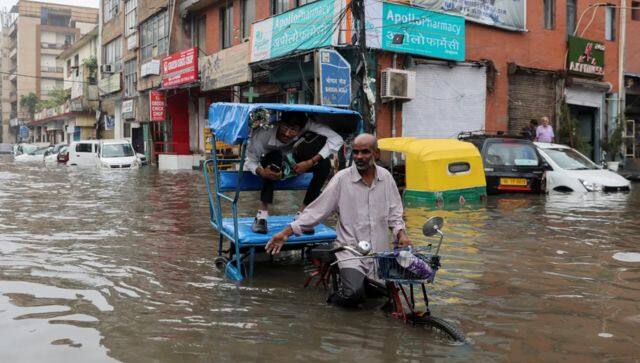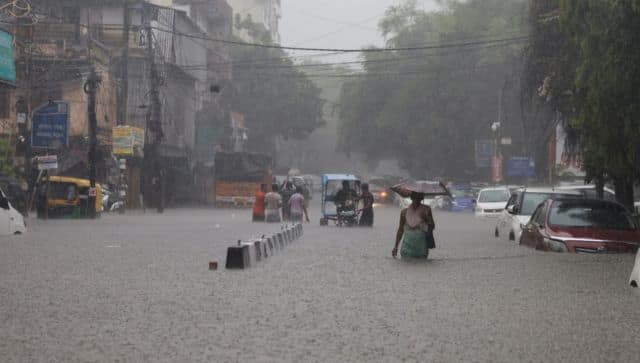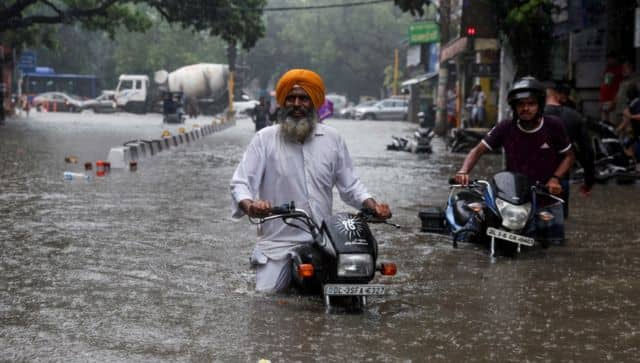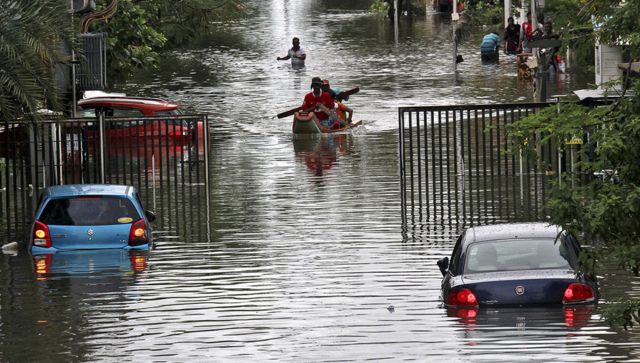Torrential rain has unleashed havoc across northern India, killing at least 22 people and causing landslides and flash floods in the region, with Delhi receiving the most rainfall in decades. Prime Minister Narendra Modi spoke with senior ministers and officials and took stock of the situation in the wake of excessive rainfall in parts of the country, his office said on Monday. Local administrations, National Disaster Response Force (NDRF) and State Disaster Response Force (SDRF) teams are working to ensure the well-being of those affected, the Prime Minister’s Office said.
“PM @narendramodi spoke to senior ministers and officials, and took stock of the situation in the wake of excessive rainfall in parts of India. Local administrations, NDRF and SDRF teams are working to ensure the well-being of those affected,” the Prime Minister’s Office (PMO) said in a tweet.
Furthermore, Delhi and NCR have witnessed an unprecedented deluge, experiencing the heaviest rainfall in decades, which prompted the closure of schools. In response to the dire situation, authorities in Himachal Pradesh where 5 killed on Sunday and Uttarakhand, located in the Himalayan states, have urged residents to remain indoors unless absolutely necessary. Authorities in Himachal Pradesh has also ordered the closure of schools and colleges for two days. [caption id=“attachment_12848482” align=“alignnone” width=“640”] Children play on a flooded street after heavy rains. In 2022, floods in India and Bangladesh left more than a dozen dead and millions homeless. Reuters[/caption] Floods across India caused a total of 656 deaths in 2021, down from some 959 deaths recorded last year. Over the last decade, the highest number of deaths due to floods across the country was in 2010, with a death toll of 965 people, according to statista.com.
WATCH: Bridges swept away as heavy rains wreak havoc in Himachal Pradesh
All major rivers are in spate, officials said, adding the local met office had issued a fresh red alert of extremely heavy rains (above 204 mm) in ten out of 12 districts, barring tribal districts of Kinnaur and Lahaul and Spiti, on July 9. Fourteen major landslides and 13 flash floods have been reported In Himchal Pradesh in the past 36 hours while over 700 roads have been closed, according to the state emergency operation centre. [caption id=“attachment_12848522” align=“alignnone” width=“640”]
Children play on a flooded street after heavy rains. In 2022, floods in India and Bangladesh left more than a dozen dead and millions homeless. Reuters[/caption] Floods across India caused a total of 656 deaths in 2021, down from some 959 deaths recorded last year. Over the last decade, the highest number of deaths due to floods across the country was in 2010, with a death toll of 965 people, according to statista.com.
WATCH: Bridges swept away as heavy rains wreak havoc in Himachal Pradesh
All major rivers are in spate, officials said, adding the local met office had issued a fresh red alert of extremely heavy rains (above 204 mm) in ten out of 12 districts, barring tribal districts of Kinnaur and Lahaul and Spiti, on July 9. Fourteen major landslides and 13 flash floods have been reported In Himchal Pradesh in the past 36 hours while over 700 roads have been closed, according to the state emergency operation centre. [caption id=“attachment_12848522” align=“alignnone” width=“640”] The pattern of monsoons has been shifting since the 1950s, with longer dry spells interspersed with heavy rain, according to Roxy Mathew Koll, a climate scientist at the Indian Institute of Tropical Meteorology in Pune. Reuters[/caption] According to the Times of India newspaper, the northern states of Himachal Pradesh, Uttarakhand, Uttar Pradesh, Jammu and Kashmir, and Punjab recorded casualties caused by floods and landslides. In Himachal Pradesh specifically, the weekend’s flash floods resulted in the collapse of a bridge and the sweeping away of several dwellings, as captured by ANI footage. To rescue those stranded on roads and bridges due to the relentless rain, authorities resorted to the use of helicopters. Reports from local media indicate that streets in various northern states, including Punjab, Delhi, and Uttarakhand, have succumbed to flooding. In certain areas, rescue teams have employed rubber rafts to reach individuals trapped inside their homes. Meanwhile, numerous roads in different parts of Delhi were submerged under knee-deep water on Sunday, experiencing the highest single-day precipitation for the month of July in 40 years, amounting to 153mm of rain. Schools in Delhi were closed after heavy rains lashed the national capital over the weekend, and authorities in the Himalayan states of Himachal Pradesh and Uttarakhand asked people not to venture out of their homes unless necessary. [caption id=“attachment_12848532” align=“alignnone” width=“640”]
The pattern of monsoons has been shifting since the 1950s, with longer dry spells interspersed with heavy rain, according to Roxy Mathew Koll, a climate scientist at the Indian Institute of Tropical Meteorology in Pune. Reuters[/caption] According to the Times of India newspaper, the northern states of Himachal Pradesh, Uttarakhand, Uttar Pradesh, Jammu and Kashmir, and Punjab recorded casualties caused by floods and landslides. In Himachal Pradesh specifically, the weekend’s flash floods resulted in the collapse of a bridge and the sweeping away of several dwellings, as captured by ANI footage. To rescue those stranded on roads and bridges due to the relentless rain, authorities resorted to the use of helicopters. Reports from local media indicate that streets in various northern states, including Punjab, Delhi, and Uttarakhand, have succumbed to flooding. In certain areas, rescue teams have employed rubber rafts to reach individuals trapped inside their homes. Meanwhile, numerous roads in different parts of Delhi were submerged under knee-deep water on Sunday, experiencing the highest single-day precipitation for the month of July in 40 years, amounting to 153mm of rain. Schools in Delhi were closed after heavy rains lashed the national capital over the weekend, and authorities in the Himalayan states of Himachal Pradesh and Uttarakhand asked people not to venture out of their homes unless necessary. [caption id=“attachment_12848532” align=“alignnone” width=“640”] A man on his motorbike wades through a flooded street after heavy rains. Fuel demand in India, the world’s third-biggest oil importer and consumer, typically falls during the four-month monsoon season beginning in June as parts of the country are hit by heavy floods. Reuters[/caption] A senior weather department official revealed that multiple districts in Himachal Pradesh witnessed a month’s worth of rainfall in just one day over the weekend. In the current monsoon season that commenced on June 1, Delhi, Punjab, and Himachal Pradesh have received rainfall exceeding the average by 112%, 100%, and 70% respectively, as reported by the weather department. On Sunday, the Press Trust of India news agency reported that six northern Indian states suffered 15 fatalities within a span of 24 hours. Omkar Sharma, a disaster management official, shared that landslides in Himachal Pradesh have resulted in the blockage of approximately 700 roads, further exacerbating the crisis. India’s meteorological department has predicted more rain across significant portions of northern India in the forthcoming days. The summer monsoon, responsible for supplying 70-80% of South Asia’s annual rainfall, also brings with it the unfortunate consequences of flooding and landslides. While forecasting the exact patterns of such rainfall remains challenging due to its erratic nature, scientists assert that climate change is amplifying the strength and unpredictability of the monsoon.
A man on his motorbike wades through a flooded street after heavy rains. Fuel demand in India, the world’s third-biggest oil importer and consumer, typically falls during the four-month monsoon season beginning in June as parts of the country are hit by heavy floods. Reuters[/caption] A senior weather department official revealed that multiple districts in Himachal Pradesh witnessed a month’s worth of rainfall in just one day over the weekend. In the current monsoon season that commenced on June 1, Delhi, Punjab, and Himachal Pradesh have received rainfall exceeding the average by 112%, 100%, and 70% respectively, as reported by the weather department. On Sunday, the Press Trust of India news agency reported that six northern Indian states suffered 15 fatalities within a span of 24 hours. Omkar Sharma, a disaster management official, shared that landslides in Himachal Pradesh have resulted in the blockage of approximately 700 roads, further exacerbating the crisis. India’s meteorological department has predicted more rain across significant portions of northern India in the forthcoming days. The summer monsoon, responsible for supplying 70-80% of South Asia’s annual rainfall, also brings with it the unfortunate consequences of flooding and landslides. While forecasting the exact patterns of such rainfall remains challenging due to its erratic nature, scientists assert that climate change is amplifying the strength and unpredictability of the monsoon.
Chandan Prakash is a Chief Sub-Editor with Firstpost. He writes on politics, international affairs, health, business and economy. If you have story ideas/pitches, reach him at Chandan.Prakash@nw18.com
)